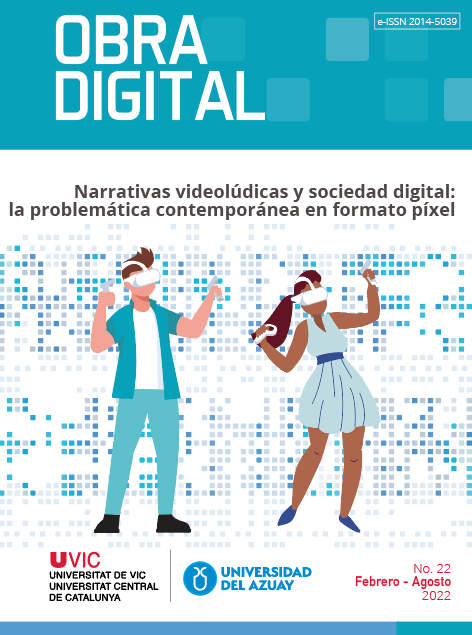"Llámame por mi nombre":
análisis de las estrategias de erosión y estereotipación de la bisexualidad en el videojuego
DOI:
https://doi.org/10.25029/od.2022.338.22Palabras clave:
Bisexualidad, Representación, Videojuegos, Estereotipos, SexualidadResumen
La bisexualidad sigue siendo una orientación invisibilizada, incluso dentro del colectivo LGBTQ. Su representación en el videojuego ha sido escasa y ambigua, mientras que en otros medios ha estado marcada por una serie de estereotipos habituales para el colectivo, fuera y dentro de la ficción. Mediante un análisis cualitativo de 98 registros de personajes bisexuales en los videojuegos, se propone una categorización de las principales estrategias de erosión y estereotipación de la bisexualidad, con el fin de profundizar en la calidad de su representación y en las características que hacen del videojuego un medio singular para este propósito.
Citas
Alexander, J. (2007). Bisexuality in the Media. Journal of Bisexuality, 7(1-2), 113-124. https://doi.org/10.1300/J159v07n01_07
Barker, M. y Langdridge, D. (2008). II. Bisexuality: Working with a Silenced Sexuality. Feminism & Psychology, 18(3), 389-394. https://doi.org/10.1177%2F0959353508092093
Bevan, R. (2021). The History of Bisexuality in Gaming. TechRaptor. (Recuperado en 04/08/2021 de https://techraptor.net/gaming/features/history-of-bisexuality-in-gaming)
Browne, T. (2014). Make up your mind! The science behind bisexuality. The Guardian. (Recuperado en 12/08/2021 de https://bit.ly/3jbEc49)
Butler, J. (1990). Gender Trouble: Feminism and the Subversion of Identity. Routledge.
Castelló, E. (2008). Identidades mediáticas. Introducción a las teorías, métodos y casos. Editorial UOC.
De Barros, A. C. (2020). "Gay Now": Bisexual Erasure in Supernatural Media from 1983 to 2003. Journal of Bisexuality, 20(1), 104-117. https://doi.org/10.1080/15299716.2020.1732258
Diamond, L. M. (2005). 'I'm Straight, but I Kissed a Girl': The Trouble with American Media Representations of Female-Female Sexuality. Feminism & Psychology, 15(1), 104-110. https://doi.org/10.1177%2F0959353505049712
Domínguez Ruiz, I. E. (2017). Bifobia: Etnografía de la bisexualidad en el activismo LGTB. Egales.
Erickson-Schroth, L. y Mitchell, J. (2009). Queering Queer Theory, or Why Bisexuality Matters. Journal of Bisexuality, 9(3-4), 297-315. https://doi.org/10.1080/15299710903316596
Flanders, C. E., LeBreton, M. E., Robinson, M., Bian, J. y Caravaca-Morera, J. A. (2017). Defining Bisexuality: Young Bisexual and Pansexual People's Voices. Journal of Bisexuality, 17(1), 39-57. https://doi.org/10.1080/15299716.2016.1227016
Fandom (2014). Lesbian or Bisexual?. (Recuperado en 26/07/2021 de https://thelastofus.fandom.com/f/p/2197332984594692614)
Flick, U. (2015). El diseño de la Investigación Cualitativa. Morata.
Gagnon, J., Greenblat, C. S. y Kimmel, M. (1999). Bisexuality: A Sociological Perspective. En E. J. Haeberle y R. Gindorf (Eds.), Bisexualities: The Ideology and Practice of Sexual Contact With Both Men and Women (pp. 81-106). Continuum International Publishing Group.
GameFAQs (2014). To put the speculation to rest, creater Neil Druckmann says Ellie is.. *spoilers. (Recuperado en 26/07/2021 de https://gamefaqs.gamespot.com/boards/652686-the-last-of-us/68629823)
Geena Davis Institute on Gender in Media (2021). The Double-Edged Sword of Online Gaming: An Analysis of Masculinity in Video Games and the Gaming Community. (Recuperado en 14/08/2021 de https://bit.ly/3jbLwNi)
Harman, K. (2019). "Bad at Love": Halsey's Bisexual Display. Journal of Bisexuality, 19(4), 554-577. https://doi.org/10.1080/15299716.2019.1695036
Hartman, J. E. (2013). Creating a Bisexual Display: Making Bisexuality Visible. Journal of Bisexuality, 13(1), 39-62. https://doi.org/10.1080/15299716.2013.755727
James, C. (1996). Denying Complexity: the dismissal and appropriation of bisexuality in queer, lesbian and gay theory. En B. Beemyn y M. Eliason (Eds.), Queer studies: a lesbian, gay, bisexual & transgender anthology (pp. 217-226). New York University Press.
Kaestle, C. E. y Ivory A. H. (2012). A Forgotten Sexuality: Content Analysis of Bisexuality in the Medical Literature over Two Decades. Journal of Bisexuality, 12(1), 35-48. https://doi.org/10.1080/15299716.2012.645701
Klesse, C. (2018). Dancing on the waves or being washed away? Representations of bisexualities in Liquid Modernity. Sexualities, 21(8), 1360-1367. https://doi.org/10.1177%2F1363460718781540
Madison, N. (2017). The Bisexual Seen: Countering Media Misrepresentation. M/C Journal, 20(4). https://doi.org/10.5204/mcj.1271
Medina-Rivera, A. (2014). Posmodernidad y bisexualidad en la obra de Bayly. Chasqui: Revista de literatura latinoamericana, 43(1), 147-157. https://www.jstor.org/stable/43589609
Meyer, M. D. E. (2010). Representing Bisexuality on Television: The Case for Intersectional Hybrids. Journal of Bisexuality, 10(4), 366-387. https://doi.org/10.1080/15299716.2010.521040
Nelson, R. (2020). 'What do bisexuals look like? I don't know!' Visibility, gender, and safety among plurisexuals. Journal of Sociology, 56(4), 591-607. https://doi.org/10.1177%2F1440783320911455
Nix (2018). ¿Y qué pasa con la bisexualidad en los videojuegos? Todas Gamers. (Recuperado en 05/08/2021 de https://todasgamers.com/2018/05/19/y-que-pasa-con-la-bisexualidad-en-los-videojuegos/)
Olvera Muñoz, O. A. (2017). La vivencia del rechazo social a la bisexualidad y su impacto en el sufrimiento psicológico. Pensamiento Crítico, 4(6), 35-44. https://bit.ly/3gvJw0B
Shaw, A. y Friesem, E. (2016). Where is the Queerness in Games?: Types of Lesbian, Gay, Bisexual, Transgender, and Queer Content in Digital Games. International Journal of Communication, 10(2016), 3877-3889. https://ijoc.org/index.php/ijoc/article/view/5449
Stechschulte, S. (2020). Through Rainbow-Colored Glasses: Overcoming Bisexual Oppression through LGBTQ+ Press. Historical Perspectives: Santa Clara University Undergraduate Journal of History, 25, 85-95. https://scholarcommons.scu.edu/historical-perspectives/vol25/iss1/11
Tierney, P. (2020). The Problem With Playersexual Romance. TheGamer. (Recuperado en 14/08/2021 de https://www.thegamer.com/playersexual-romance-bad/)
Utsch, S., Bragança, L. C., Ramos, P., Caldeira, P. y Tenorio J. (2017). Queer Identities in Video Games: Data Visualization for a Quantitative Analysis of Representation [Full Paper]. 2017 SBGames. Simpósio Brasileiro de Jogos e Entretenimento Digital. Curitibia, Brasil. https://www.sbgames.org/sbgames2017/papers/CulturaFull/175360.pdf
White, J. D. (2001). Bisexuals Who Kill: Hollywood's Bisexual Crimewave, 1985-1998. Journal of Bisexuality, 2(1), 39-54. https://doi.org/10.1300/J159v02n01_04
Yoshino, K. (2000). The epistemic contract of bisexual erasure. Stanford Law Review, 52(2), 353-461. https://bit.ly/3je9QhD
Descargas
Publicado
Cómo citar
Número
Sección
Licencia
Derechos de autor 2022 Carlos Ramírez-Moreno, Dr.

Esta obra está bajo una licencia internacional Creative Commons Atribución 4.0.
Obra Digital emplea una licencia Creative Commons 4.0 Internacional. Más información:
Derechos de autor de la revista
Creative Commons.org Licenses 4.0







